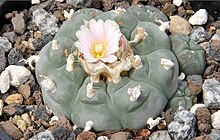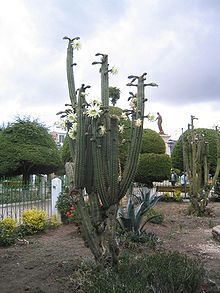Xương rồng hướng thần
| Một phần của loạt bài về |
| Thức thần |
|---|
|
Nghệ thuật |
|
Luật pháp |
|
Chủ điểm liên quan |
Nhiều loại xương rồng được biết đến là có tác dụng hướng thần, có chứa các alkaloid phenethylamine như mescaline.[1] Tuy nhiên, hai chi chính mang tính nghi lễ (dân gian) là Echinopsis, trong đó các loài có hoạt tính hướng thần mạnh nhất xuất hiện trong nhóm xương rồng San Pedro (bao gồm Echinopsis pachanoi, đồng nghĩa Trichocereus pachanoi, Echinopsis peruviana, đồng nghĩa Trichocereus peruvianus và Echinopsis lageniformis, đồng nghĩa Trichocereus bridgeii[2][3]) và Lophophora, với Lophophora williamsii là loài có hoạt tính hướng thần mạnh nhất. Một số loài khác thuộc các chi khác cũng có hoạt tính hướng thần, mặc dù không phải lúc nào cũng được sử dụng với mục đích nghi lễ.[4][5][6]
Loài
[sửa | sửa mã nguồn]Xương rồng cầu
[sửa | sửa mã nguồn]- Lophophora williamsii (peyote)

Các "peyote" khác
- Ariocarpus fissuratus
- Coryphantha compacta (syn. C. palmeri)
- Pelecyphora aselliformis
- Pelecyphora strobiliformis
- Lophophora diffusa
- Ariocarpus retusus
- Ariocarpus agavoides; kotschoubeyanus; và các loài khác
- Astrophytum asterias; capricorne; myriostigma; và các loài khác
- Aztekium ritteri; và các loài khác
- Coryphantha elephantidens; macromeris (var. runyonii); palmeri; và các loài khác
- Echinocactus grandis; grusonii; platyacanthus; visnaga; và các loài khác
- Epithelantha micromeris; và các loài khác
- Leuchtenbergia principis'; và các loài khác
- Lophophora species
- Mammillaria craigii; grahamii (var. oliviae); heyderi; (Dolichothele) longimamma; (Solisia) pectinifera; (Mamillopsis) senilis; sonorensis; và các loài khác
- Obregonia denegrii
- Strombocactus disciformis
- Turbinicarpus laui; lophophoroides; jauernigii; (Pelecyphora) pseudopectinatus; schmiedickeanus; và các loài khác
Khác
[sửa | sửa mã nguồn]Các loại xương rồng có hoạt tính hướng thần và/hoặc dược liệu khác ở Bắc Mỹ.
- Carnegiea gigantea
- Echinocereus salm-dyckianus (var. scheeri); triglochidiatus; và các loài khác
- Pachycereus pecten-aboriginum; pringlei
Xương rồng hình cây và hình cột
[sửa | sửa mã nguồn]Echinopsis
[sửa | sửa mã nguồn]- Echinopsis lageniformis (syn. Trichocereus bridgesii)
- Echinopsis macrogona (syn. Trichocereus macrogonus), > 0.01-0.05% Mescaline[7]
- Echinopsis pasacana ssp. atacamensis
- Echinopsis pachanoi (syn. Trichocereus pachanoi)
- Echinopsis peruviana (syn. Trichocereus peruvianus)
- Echinopsis scopulicola (syn. Trichocereus scopulicolus), 0.82% mescaline theo khối lượng khô trong lớp xanh bên ngoài.[8]
- Echinopsis spachiana (syn. Trichocereus spachianus), Mescaline;[9] Mescaline[9]
- Echinopsis tacaquirensis subsp. taquimbalensis (syn. Trichocereus taquimbalensis),[10] > 0.005-0.025% mescaline[7]
- Echinopsis terscheckii (syn. Trichocereus terscheckii, Trichocereus werdemannianus)[11] > 0.005-0.025% Mescaline;[7] mescaline 0.01%-2.375%[12]
- Echinopsis valida (syn. E. validus), 0.025% mescaline[13]
- Echinopsis werdermannianus

Khác
[sửa | sửa mã nguồn]Các loại xương rồng có hoạt tính hướng thần và/hoặc dược liệu khác ở Nam Mỹ
- Austrocylindropuntia cylindrica (syn. Opuntia cylindrica),[14] Mescaline[9]
- Armatocereus laetus
- Browningia spp.
- Cylindropuntia echinocarpa (syn. Opuntia echinocarpa), Mescaline 0.01%, DMPEA 0.01%, 4-hydroxy-3-5-dimethoxyphenethylamine 0.01%[9]
- Cylindropuntia spinosior (syn. Opuntia spinosior),[15] Mescaline 0.00004%, 3-methoxytyramine 0.001%, tyramine 0.002%, 3-4-dimethoxyphenethylamine.[9]
- Epostoa lanata
- Matucana madisoniorum
- Neoraimondia macrostibas
- Opuntia acanthocarpa Mescaline[16]
- Opuntia basilaris Mescaline 0.01%, plus 4-hydroxy-3-5-dimethoxyphenethylamine[9]
- Selenicereus grandiflorus
- Stetsonia coryne
Xem thêm
[sửa | sửa mã nguồn]Tham khảo
[sửa | sửa mã nguồn]- ^ Bruhn, Jan G.; Hesham R. EI-Seedi; Nikolai Stephanson (2008). “Ecstasy Analogues Found in Cacti”. Journal of Psychoactive Drugs. 40 (2): 219–222. CiteSeerX 10.1.1.689.4014. doi:10.1080/02791072.2008.10400635. PMID 18720674. S2CID 11251286.
- ^ Engel, Liam (2022). The San Pedro Appreciation Guide. The Mescaline Garden.
- ^ Engel, L. Barratt, M. Ferris, J. Puljevic, C. Winstock, A. (2023). “Mescaline, Peyote and San Pedro: Is sustainability important for cacti consumers?”. Journal of Psychedelic Studies.Quản lý CS1: nhiều tên: danh sách tác giả (liên kết)
- ^ Bruhn, Jan G. (1973). “Ethnobotanical Search for Hallucinogenic Cacti1”. Planta Med. 24 (8): 315–319. doi:10.1055/s-0028-1099504. PMID 4789553.
- ^ Bruhn, Jan G.; Catarina Bruhn (1973). “Alkaloids and ethnobotany of Mexican peyote cacti and related species”. Economic Botany. 27 (2): 241–251. doi:10.1007/BF02872994. S2CID 36480873.
- ^ Pummangura, S.; J. L. McLaughlin; R. C. Schifferdecker (tháng 9 năm 1981). “Cactus Alkaloids. XLVII. β-Phenethylamines From the "Missouri Pincushion", Coryphantha (Neobessya) missouriensis”. J. Nat. Prod. 44 (5): 614–616. doi:10.1021/np50017a022.
- ^ a b c “Partial List of Alkaloids in Trichocereus Cacti”. Thennok.org. Bản gốc lưu trữ ngày 11 tháng 2 năm 2009. Truy cập ngày 22 tháng 12 năm 2017.
- ^ Ogunbodede, Olabode; McCombs, Douglas; Trout, Keeper; Daley, Paul; Terry, Martin (tháng 9 năm 2010). “New mescaline concentrations from 14 taxa/cultivars of Echinopsis spp. (Cactaceae) ("San Pedro") and their relevance to shamanic practice”. Journal of Ethnopharmacology. 131 (2): 356–362. doi:10.1016/j.jep.2010.07.021. PMID 20637277.
- ^ a b c d e f “Descriptions of psychoactive Cacti”. Users.lycaeum.org. Bản gốc lưu trữ ngày 15 tháng 7 năm 2009. Truy cập ngày 14 tháng 1 năm 2015.
- ^ “Echinopsis tacaquirensis ssp. taquimbalensis”. Desert-tropicals.com. Bản gốc lưu trữ ngày 23 tháng 9 năm 2015. Truy cập ngày 14 tháng 1 năm 2015.
- ^ “Cardon Grande (Echinopsis terscheckii)”. Desert-tropicals.com. Bản gốc lưu trữ ngày 5 tháng 4 năm 2015. Truy cập ngày 14 tháng 1 năm 2015.
- ^ Forbidden Fruit Archives Lưu trữ 2005-11-28 tại Wayback Machine
- ^ “Erowid Cacti Vaults : Visionary Cactus Guide - Mescaline from Sawdust”. Erowid.org. Truy cập ngày 14 tháng 1 năm 2015.
- ^ “Austrocylindropuntia cylindrica”. Desert-tropicals.com. Bản gốc lưu trữ ngày 11 tháng 10 năm 2008. Truy cập ngày 22 tháng 12 năm 2017.
- ^ “Cane Cholla (Cylindropuntia spinosior )”. Desert-tropicals.com. Bản gốc lưu trữ ngày 29 tháng 12 năm 2014. Truy cập ngày 14 tháng 1 năm 2015.
- ^ “Archived copy”. users.lycaeum.org. Bản gốc lưu trữ ngày 8 tháng 3 năm 2001. Truy cập ngày 17 tháng 1 năm 2022.Quản lý CS1: bản lưu trữ là tiêu đề (liên kết)
Liên kết ngoài
[sửa | sửa mã nguồn] Tư liệu liên quan tới Psychoactive cacti tại Wikimedia Commons
Tư liệu liên quan tới Psychoactive cacti tại Wikimedia Commons- www.cactus-mall.com